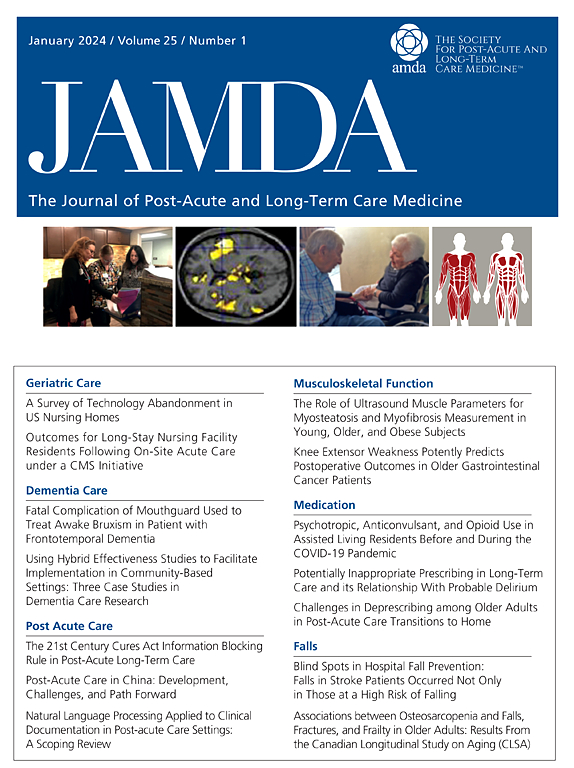Hospitalization-Associated Disability and 1-Year Mortality Risk in Older Patients With Heart Failure
IF 4.2
2区 医学
Q2 GERIATRICS & GERONTOLOGY
Journal of the American Medical Directors Association
Pub Date : 2025-05-13
DOI:10.1016/j.jamda.2025.105549
引用次数: 0
Abstract
Objectives
Hospitalization-associated disability (HAD) is the loss of the ability to perform one of the basic activities of daily living (ADLs) required for independent living during hospitalization. This study aimed to determine whether HAD is a significant prognostic risk factor in older patients with heart failure (HF) and independent ADLs.
Design
Prospective, nationwide, multicenter registry study conducted between December 2020 and March 2022.
Setting and Participants
This study was conducted across 96 centers in Japan and included 6519 older patients (aged ≥65 years) with HF who were independent in ADL before hospitalization.
Methods
HAD was defined as a drop of at least 5 points in the Barthel Index (BI) at discharge, relative to a stable score before hospitalization. Subgroup analysis classified HAD as mild (a decrease of 5–15 points in the BI) and severe (a decrease of ≥20 points in the BI). The primary outcome was all-cause mortality within 1 year after hospital discharge, and the secondary outcomes were HF-related mortality and rehospitalization.
Results
All-cause mortality, HF-related mortality, and rehospitalization rates within 1 year were 12%, 5%, and 41%, respectively. Multivariate Cox regression analysis revealed that HAD increased the risk of 1-year all-cause mortality after hospital discharge (adjusted hazard ratio, 1.749; 95% CI, 1.475–2.075). Subgroup analysis showed a significantly higher risk of all-cause mortality among patients with severe HAD than among those with mild HAD (1.388; 1.109–1.739). HAD was a significant risk factor for HF-related mortality (1.556; 1.216–2.017). However, no relationship was observed between HAD and readmission (1.062; 0.970–1.163).
Conclusions and Implications
The development of HAD was identified as a significant risk factor for 1-year post-discharge mortality among older patients with HF who were independent in ADLs before hospitalization. Preventing minor declines in ADL and mitigating any ADL impairments during hospitalization are crucial to avoiding a worsening prognosis.
老年心力衰竭患者住院相关残疾和1年死亡风险
目的:住院相关残疾(HAD)是指住院期间丧失独立生活所需的基本日常生活活动(adl)之一的能力。本研究旨在确定HAD是否是老年心力衰竭(HF)和独立adl患者的重要预后危险因素。设计:在2020年12月至2022年3月期间进行的前瞻性、全国性、多中心注册研究。环境和参与者:本研究在日本的96个中心进行,包括6519名住院前独立于ADL的HF老年患者(年龄≥65岁)。方法:HAD定义为出院时Barthel指数(BI)相对于住院前的稳定评分下降至少5分。亚组分析将HAD分为轻度(BI下降5-15分)和重度(BI下降≥20分)。主要结局是出院后1年内的全因死亡率,次要结局是hf相关死亡率和再住院率。结果:1年内全因死亡率、hf相关死亡率和再住院率分别为12%、5%和41%。多因素Cox回归分析显示,HAD增加了出院后1年全因死亡的风险(校正风险比为1.749;95% ci, 1.475-2.075)。亚组分析显示,重度HAD患者的全因死亡风险显著高于轻度HAD患者(1.388;1.109 - -1.739)。HAD是hf相关死亡率的重要危险因素(1.556;1.216 - -2.017)。然而,HAD与再入院没有关系(1.062;0.970 - -1.163)。结论和意义:在住院前独立于ADLs的老年HF患者中,HAD的发展被确定为出院后1年死亡率的重要危险因素。在住院期间预防ADL的轻微下降和减轻任何ADL损伤对于避免预后恶化至关重要。
本文章由计算机程序翻译,如有差异,请以英文原文为准。
求助全文
约1分钟内获得全文
求助全文
来源期刊
CiteScore
11.10
自引率
6.60%
发文量
472
审稿时长
44 days
期刊介绍:
JAMDA, the official journal of AMDA - The Society for Post-Acute and Long-Term Care Medicine, is a leading peer-reviewed publication that offers practical information and research geared towards healthcare professionals in the post-acute and long-term care fields. It is also a valuable resource for policy-makers, organizational leaders, educators, and advocates.
The journal provides essential information for various healthcare professionals such as medical directors, attending physicians, nurses, consultant pharmacists, geriatric psychiatrists, nurse practitioners, physician assistants, physical and occupational therapists, social workers, and others involved in providing, overseeing, and promoting quality

 求助内容:
求助内容: 应助结果提醒方式:
应助结果提醒方式:


